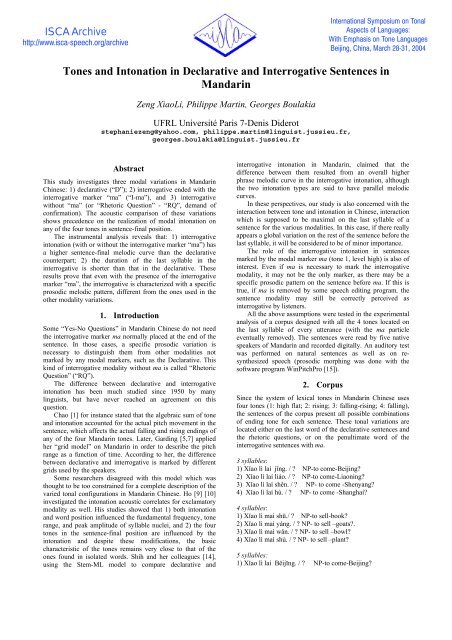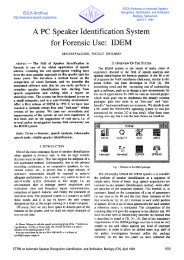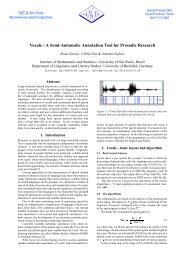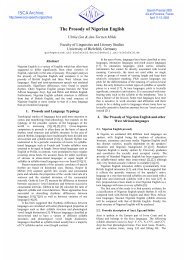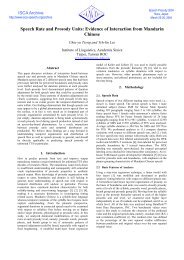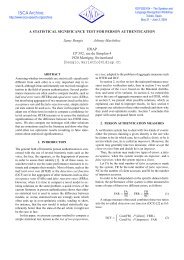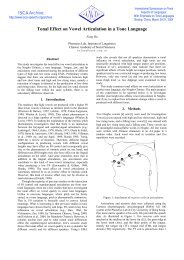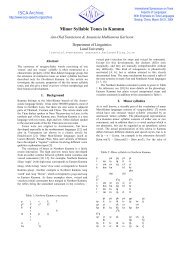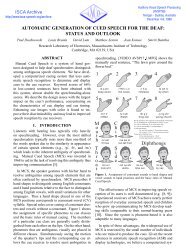Tones and Intonation in Declarative and Interrogative ... - ISCA!
Tones and Intonation in Declarative and Interrogative ... - ISCA!
Tones and Intonation in Declarative and Interrogative ... - ISCA!
Create successful ePaper yourself
Turn your PDF publications into a flip-book with our unique Google optimized e-Paper software.
<strong>ISCA</strong> Archive<br />
http://www.isca-speech.org/archive<br />
International Symposium on Tonal<br />
Aspects of Languages:<br />
With Emphasis on Tone Languages<br />
Beij<strong>in</strong>g, Ch<strong>in</strong>a, March 28-31, 2004<br />
<strong>Tones</strong> <strong>and</strong> <strong>Intonation</strong> <strong>in</strong> <strong>Declarative</strong> <strong>and</strong> <strong>Interrogative</strong> Sentences <strong>in</strong><br />
M<strong>and</strong>ar<strong>in</strong><br />
Zeng XiaoLi, Philippe Mart<strong>in</strong>, Georges Boulakia<br />
UFRL Université Paris 7-Denis Diderot<br />
stephaniezeng@yahoo.com, philippe.mart<strong>in</strong>@l<strong>in</strong>guist.jussieu.fr,<br />
georges.boulakia@l<strong>in</strong>guist.jussieu.fr<br />
Abstract<br />
This study <strong>in</strong>vestigates three modal variations <strong>in</strong> M<strong>and</strong>ar<strong>in</strong><br />
Ch<strong>in</strong>ese: 1) declarative (“D”); 2) <strong>in</strong>terrogative ended with the<br />
<strong>in</strong>terrogative marker “ma” (“I-ma”), <strong>and</strong> 3) <strong>in</strong>terrogative<br />
without “ma” (or “Rhetoric Question” - “RQ”, dem<strong>and</strong> of<br />
confirmation). The acoustic comparison of these variations<br />
shows precedence on the realization of modal <strong>in</strong>tonation on<br />
any of the four tones <strong>in</strong> sentence-f<strong>in</strong>al position.<br />
The <strong>in</strong>strumental analysis reveals that: 1) <strong>in</strong>terrogative<br />
<strong>in</strong>tonation (with or without the <strong>in</strong>terrogative marker “ma”) has<br />
a higher sentence-f<strong>in</strong>al melodic curve than the declarative<br />
counterpart; 2) the duration of the last syllable <strong>in</strong> the<br />
<strong>in</strong>terrogative is shorter than that <strong>in</strong> the declarative. These<br />
results prove that even with the presence of the <strong>in</strong>terrogative<br />
marker “ma”, the <strong>in</strong>terrogative is characterized with a specific<br />
prosodic melodic pattern, different from the ones used <strong>in</strong> the<br />
other modality variations.<br />
1. Introduction<br />
Some “Yes-No Questions” <strong>in</strong> M<strong>and</strong>ar<strong>in</strong> Ch<strong>in</strong>ese do not need<br />
the <strong>in</strong>terrogative marker ma normally placed at the end of the<br />
sentence. In those cases, a specific prosodic variation is<br />
necessary to dist<strong>in</strong>guish them from other modalities not<br />
marked by any modal markers, such as the <strong>Declarative</strong>. This<br />
k<strong>in</strong>d of <strong>in</strong>terrogative modality without ma is called “Rhetoric<br />
Question” (“RQ”).<br />
The difference between declarative <strong>and</strong> <strong>in</strong>terrogative<br />
<strong>in</strong>tonation has been much studied s<strong>in</strong>ce 1950 by many<br />
l<strong>in</strong>guists, but have never reached an agreement on this<br />
question.<br />
Chao [1] for <strong>in</strong>stance stated that the algebraic sum of tone<br />
<strong>and</strong> <strong>in</strong>tonation accounted for the actual pitch movement <strong>in</strong> the<br />
sentence, which affects the actual fall<strong>in</strong>g <strong>and</strong> ris<strong>in</strong>g end<strong>in</strong>gs of<br />
any of the four M<strong>and</strong>ar<strong>in</strong> tones. Later, Gard<strong>in</strong>g [5,7] applied<br />
her “grid model” on M<strong>and</strong>ar<strong>in</strong> <strong>in</strong> order to describe the pitch<br />
range as a function of time. Accord<strong>in</strong>g to her, the difference<br />
between declarative <strong>and</strong> <strong>in</strong>terrogative is marked by different<br />
grids used by the speakers.<br />
Some researchers disagreed with this model which was<br />
thought to be too constra<strong>in</strong>ed for a complete description of the<br />
varied tonal configurations <strong>in</strong> M<strong>and</strong>ar<strong>in</strong> Ch<strong>in</strong>ese. Ho [9] [10]<br />
<strong>in</strong>vestigated the <strong>in</strong>tonation acoustic correlates for exclamatory<br />
modality as well. His studies showed that 1) both <strong>in</strong>tonation<br />
<strong>and</strong> word position <strong>in</strong>fluenced the fundamental frequency, tone<br />
range, <strong>and</strong> peak amplitude of syllable nuclei, <strong>and</strong> 2) the four<br />
tones <strong>in</strong> the sentence-f<strong>in</strong>al position are <strong>in</strong>fluenced by the<br />
<strong>in</strong>tonation <strong>and</strong> despite these modifications, the basic<br />
characteristic of the tones rema<strong>in</strong>s very close to that of the<br />
ones found <strong>in</strong> isolated words. Shih <strong>and</strong> her colleagues [14],<br />
us<strong>in</strong>g the Stem-ML model to compare declarative <strong>and</strong><br />
<strong>in</strong>terrogative <strong>in</strong>tonation <strong>in</strong> M<strong>and</strong>ar<strong>in</strong>, claimed that the<br />
difference between them resulted from an overall higher<br />
phrase melodic curve <strong>in</strong> the <strong>in</strong>terrogative <strong>in</strong>tonation, although<br />
the two <strong>in</strong>tonation types are said to have parallel melodic<br />
curves.<br />
In these perspectives, our study is also concerned with the<br />
<strong>in</strong>teraction between tone <strong>and</strong> <strong>in</strong>tonation <strong>in</strong> Ch<strong>in</strong>ese, <strong>in</strong>teraction<br />
which is supposed to be maximal on the last syllable of a<br />
sentence for the various modalities. In this case, if there really<br />
appears a global variation on the rest of the sentence before the<br />
last syllable, it will be considered to be of m<strong>in</strong>or importance.<br />
The role of the <strong>in</strong>terrogative <strong>in</strong>tonation <strong>in</strong> sentences<br />
marked by the modal marker ma (tone 1, level high) is also of<br />
<strong>in</strong>terest. Even if ma is necessary to mark the <strong>in</strong>terrogative<br />
modality, it may not be the only marker, as there may be a<br />
specific prosodic pattern on the sentence before ma. If this is<br />
true, if ma is removed by some speech edit<strong>in</strong>g program, the<br />
sentence modality may still be correctly perceived as<br />
<strong>in</strong>terrogative by listeners.<br />
All the above assumptions were tested <strong>in</strong> the experimental<br />
analysis of a corpus designed with all the 4 tones located on<br />
the last syllable of every utterance (with the ma particle<br />
eventually removed). The sentences were read by five native<br />
speakers of M<strong>and</strong>ar<strong>in</strong> <strong>and</strong> recorded digitally. An auditory test<br />
was performed on natural sentences as well as on resynthesized<br />
speech (prosodic morph<strong>in</strong>g was done with the<br />
software program W<strong>in</strong>PitchPro [15]).<br />
2. Corpus<br />
S<strong>in</strong>ce the system of lexical tones <strong>in</strong> M<strong>and</strong>ar<strong>in</strong> Ch<strong>in</strong>ese uses<br />
four tones (1: high flat; 2: ris<strong>in</strong>g; 3: fall<strong>in</strong>g-ris<strong>in</strong>g; 4: fall<strong>in</strong>g),<br />
the sentences of the corpus present all possible comb<strong>in</strong>ations<br />
of end<strong>in</strong>g tone for each sentence. These tonal variations are<br />
located either on the last word of the declarative sentences <strong>and</strong><br />
the rhetoric questions, or on the penultimate word of the<br />
<strong>in</strong>terrogative sentences with ma.<br />
3 syllables:<br />
1) Xǐao lì laí jīng. / ? NP-to come-Beij<strong>in</strong>g?<br />
2) Xǐao lì laí liáo. / ? NP-to come-Liaon<strong>in</strong>g?<br />
3) Xǐao lì laí shěn. / ? NP- to come -Shenyang?<br />
4) Xǐao lì laí hù. / ? NP- to come -Shanghai?<br />
4 syllables:<br />
1) Xǐao lì maì shū./ ? NP-to sell-book?<br />
2) Xǐao lì maì yáng. / ? NP- to sell –goats?.<br />
3) Xǐao lì maì wǎn. / ? NP- to sell –bowl?<br />
4) Xǐao lì maì shù. / ? NP- to sell –plant?<br />
5 syllables:<br />
1) Xǐao lì laí Běijīng. / ? NP-to come-Beij<strong>in</strong>g?
2) Xǐao lì laí Héféi. / ? NP- to come -Hefei.<br />
3) Xǐao lì laí Shànghǎi. / ? NP- to come –Shanghai?<br />
4) Xǐao lì laí Wǔhàn. / ? NP- to come –Wuhan?<br />
6 syllables:<br />
1) Xǐao lì xǐ huān gǔ zhēng. / ? NP-to like-harp ?<br />
2) Xǐao lì xǐ huān zhōng wén. / ? NP- to like –M<strong>and</strong>ar<strong>in</strong>?<br />
3) Xǐao lì xǐ huān dé yǔ. / ? NP- to like –German?<br />
4) Xǐao lì xǐ huān huà jù. / ? NP-to like-theater?<br />
8 syllables:<br />
1) Xǐao lì xǐ huān xué xí gǔ zhēng. / ?<br />
NP-to like-to learn-harp?<br />
2) Xǐao lì xǐ huān xué xí zhōng wén. / ?<br />
NP- to like-to learn –m<strong>and</strong>ar<strong>in</strong>?<br />
3) Xǐao lì xǐ huān xué xí dé yǔ. / ?<br />
NP- to like-to learn –German?<br />
4) Xǐao lì xǐ huān xué xí huà jù. / ?<br />
NP- to like-to learn –theater?<br />
10 syllables:<br />
1) Xǐao lì kāi shǐ xǐ huān xué xí gǔ zhēng. / ? We obta<strong>in</strong>ed the follow<strong>in</strong>g results:<br />
NP-to start-to like-to learn-harp?<br />
2) Xǐao lì kāi shǐ xǐ huān xué xí zhōng wén. / ?<br />
NP- to start-to like-to learn –M<strong>and</strong>ar<strong>in</strong>?<br />
3) Xǐao lì kāi shǐ x ǐhuān xué xí dé yǔ. / ?<br />
NP-c to start-to like-to learn –German?<br />
4) Xǐao lì kāi shǐ xǐ huān xué xí huà jù. / ?<br />
NP- to start-to like-to learn –theater?<br />
The corpus is composed of 72 sentences read by 5<br />
speakers (3 females <strong>and</strong> 2 males), from North <strong>and</strong> South of<br />
Ch<strong>in</strong>a. The total number of sentences obta<strong>in</strong>ed is 360, which<br />
were subdivided <strong>in</strong>to 4 groups accord<strong>in</strong>g to the type of tone.<br />
All the sentences, presented <strong>in</strong> r<strong>and</strong>om order to the<br />
speakers, were ended with the punctuation markers: “.” or “?”.<br />
The record<strong>in</strong>g of each sentence was repeated three times, with<br />
a r<strong>and</strong>omization of the read<strong>in</strong>g order different at each time.<br />
3.2 Instrumental analysis<br />
The fundamental frequency <strong>and</strong> duration of the last syllable<br />
nuclei (or of the penultimate syllable <strong>in</strong> the <strong>in</strong>terrogative<br />
sentences with ma, which is an identical syllable when<br />
compared to the “D” <strong>and</strong> the “RQ” cases) were measured for<br />
the 360 sentences, <strong>and</strong> the data were then transferred on Excel.<br />
Statistic analysis revealed the existence of three groups<br />
that were different <strong>in</strong> a significant way, not only for the F0<br />
analysis but also for the duration analysis, as shown <strong>in</strong> the<br />
figures below.<br />
3.3 Fundamental frequency<br />
The comparative F0 analysis for the three modalities was<br />
performed <strong>in</strong> terms of the tonal contour <strong>and</strong> global register.<br />
In this case, the analysis could not neglect the actual tonal<br />
realisations <strong>in</strong> different tonal contexts. Indeed, four tones were<br />
classified <strong>in</strong>to two groups accord<strong>in</strong>g to the shape of the F0<br />
contour: flat contours (Tone 1 <strong>and</strong> tone 4) <strong>and</strong> modulated<br />
contours (Tone 2 <strong>and</strong> Tone 3).<br />
3.1 Auditory test<br />
3. Experimental analysis<br />
The test had two objectives: 1) verify the recorded declarative<br />
sentences <strong>and</strong> the rhetoric questions, <strong>and</strong> 2) establish the<br />
perception of the <strong>in</strong>terrogative sentences where ma has been<br />
<strong>in</strong>tentionally removed.<br />
Ten listeners were <strong>in</strong>vited to participate <strong>in</strong> the test. They<br />
were asked to judge the modality between “D” <strong>and</strong> “RQ” on a<br />
five-degree scale. The subject listened twice to all sentences,<br />
which were presented every time <strong>in</strong> a r<strong>and</strong>om order.<br />
All the responses were analysed with Excel® <strong>and</strong> an<br />
ANOVA test was executed with the statistical analysis<br />
program StatView®. The test results confirmed the importance<br />
of the prosodic features. Firstly, the type “D” <strong>and</strong> type “RQ”<br />
sentences were differentiated with a high certa<strong>in</strong>ty. Secondly,<br />
the ma truncated <strong>in</strong>terrogative sentences provoked a great<br />
uncerta<strong>in</strong>ty <strong>in</strong> the listeners’ judgments. Although the response<br />
of most subjects showed a certa<strong>in</strong> bias toward type “D”, a<br />
significant difference from the other two types was revealed<br />
by the ANOVA test. This seems to demonstrate the primacy of<br />
the morpho-syntactic structure when the prosody is atypical, as<br />
it was confirmed later by the <strong>in</strong>strumental analysis.
TP: Turn<strong>in</strong>g Po<strong>in</strong>t<br />
Figure 1. Fundamental frequency of the last tone for<br />
declarative, rhetorical question <strong>and</strong> ma <strong>in</strong>terrogative<br />
sentences.<br />
The acoustical analysis showed that:<br />
1. The four <strong>in</strong>terrogative sentences tones, with or<br />
without ma, are placed on a higher register than the declarative<br />
counterparts. The register was the highest <strong>in</strong> rhetoric questions.<br />
2. The tonal realisations were modified <strong>in</strong> a significant<br />
way accord<strong>in</strong>g to the type of utterance. Tone 1, “flat”, became<br />
ascend<strong>in</strong>g <strong>in</strong> rhetoric questions; Tone 4, “descend<strong>in</strong>g”, was<br />
characterised by a less accentuated slope; Tone 3,<br />
“descend<strong>in</strong>g-ascend<strong>in</strong>g”, <strong>and</strong> Tone 2 which was realised <strong>in</strong> the<br />
same manner because of the contextual assimilation, weren’t<br />
much affected by the modality, except that they possessed a<br />
higher register, <strong>and</strong> the second part of the contour (the reascend<strong>in</strong>g<br />
part) ascended much higher <strong>in</strong> rhetoric questions.<br />
3. Despite the significant difference between “D” <strong>and</strong><br />
“RQ” for four tones, “D” wasn’t significantly different from<br />
“I-ma” <strong>in</strong> the case of <strong>Tones</strong> 2 <strong>and</strong> 3. Therefore, another<br />
acoustic parameter, duration had to be also considered.<br />
3.4 Duration<br />
The analysis consisted of two steps: a) the analysis of the<br />
“absolute duration” (the duration of the syllable nuclei <strong>in</strong><br />
milliseconds); b) the analysis of the “relative duration” (the<br />
duration of the syllable nuclei compared to the duration of the<br />
whole sentence). The first step helped us to underst<strong>and</strong> the<br />
acoustic differences for different modalities; the second step<br />
allowed us to verify the results of the first step <strong>in</strong> the resynthesis.<br />
The results were:<br />
1. The “absolute duration” <strong>in</strong> “I-ma” was notably the<br />
shortest compared to that <strong>in</strong> “D” <strong>and</strong> “RQ”; the “absolute<br />
duration” <strong>in</strong> “RQ” was shorter than that <strong>in</strong> “D”;<br />
2. On the sentence-f<strong>in</strong>al position, the “relative duration” of<br />
<strong>Tones</strong> 1, 2, <strong>and</strong> 3 was the same for “D” <strong>and</strong> “RQ”, but much<br />
shorter for “I-ma”, regard<strong>in</strong>g Tone 4, the relative duration was<br />
longer for “RQ”;<br />
3. A special case for Tone 2 <strong>and</strong> 3 <strong>in</strong> the rhetoric questions<br />
was that the “relative duration” of the ascend<strong>in</strong>g part of the<br />
contour was much longer than that of the descend<strong>in</strong>g part<br />
(shown as follows <strong>in</strong> graphs below).<br />
Figure 2. Results of the auditory tests for declarative,<br />
rhetorical question <strong>and</strong> ma <strong>in</strong>terrogative sentences.<br />
We can then conclude that both fundamental frequency<br />
<strong>and</strong> duration are used to dist<strong>in</strong>guish between “<strong>Declarative</strong>”,<br />
“Rhetoric Question” <strong>and</strong> “<strong>Interrogative</strong> with ma”.<br />
3.5 Re-synthesis<br />
The prosodic morph<strong>in</strong>g done by re-synthesis did confirm the<br />
acoustical analysis results. The orig<strong>in</strong>al Fo <strong>and</strong> duration values<br />
of segments of the sentences were modified with W<strong>in</strong>PitchPro,<br />
<strong>and</strong> the re-synthesized sentences went aga<strong>in</strong> through a<br />
perceptive test.<br />
Three types of the manipulations were performed:<br />
1. Stylization of different typical realizations that would be<br />
recognized as they were through the perceptive test;<br />
2. Variation, <strong>in</strong> a progressive way, of the contour of the<br />
f<strong>in</strong>al tone, <strong>and</strong> of the register if necessary, <strong>in</strong> order to put <strong>in</strong><br />
evidence not only a typical pitch-pattern of the two modalities<br />
“D” <strong>and</strong> “RQ”, also their category frontier;<br />
3. Variation of the duration <strong>in</strong> the pert<strong>in</strong>ent cases that were<br />
anticipated by the <strong>in</strong>strumental analysis.<br />
Compared to “D”, “RQ” sentences were characterized by a<br />
higher register <strong>and</strong> an upward tendency even for the<br />
descend<strong>in</strong>g tone 4 on the sentence-f<strong>in</strong>al position. Controll<strong>in</strong>g<br />
F0 an duration with re-synthesized speech, we could obta<strong>in</strong><br />
target values which were recognized as well as the perceptual<br />
boundaries between the two categories.
4. Conclusion<br />
This <strong>in</strong>vestigation <strong>in</strong> different modalities confirmed the results<br />
of a great number of the precedent studies (see references),<br />
which declared that the tonal languages, like Ch<strong>in</strong>ese <strong>and</strong><br />
Vietnamese, possess<strong>in</strong>g a rich system of modal morphemes,<br />
are also characterized by a dimension “<strong>in</strong>tonation” which<br />
plays an important role on the syntactical-pragmatic level.<br />
This paper attempts to demonstrate that the <strong>in</strong>terrogative<br />
modality <strong>in</strong>volves a rotation of the overall fundamental<br />
frequency with the penultimate syllable of the sentence as the<br />
rotation axis, rather than an overall higher shift of F0 or a<br />
higher realization of the sentence last tone.<br />
5. References<br />
[1] Chao, Yuen-Ren, 1968. A Grammar of Spoken Ch<strong>in</strong>ese,<br />
Berkeley, University of California Press.<br />
[2] Cheng, Ch<strong>in</strong>-Chuan, 1973. A Synchronic Phonology of<br />
M<strong>and</strong>ar<strong>in</strong> Ch<strong>in</strong>ese, University of Ill<strong>in</strong>ois, Mouton, Paris.<br />
[3] Cheng, Robert, 1966. M<strong>and</strong>ar<strong>in</strong> Phonological Structure,<br />
Journal of L<strong>in</strong>guistics, (2) No 2, 135-262.<br />
[4] Chu, Chauncey C., 1985. Lu’s ‘syntactic word’ <strong>and</strong><br />
Conceptual Dynamism, Journal of the Ch<strong>in</strong>ese Language<br />
Teachers Association, XX, No.1, February 1985.<br />
[5] Gård<strong>in</strong>g, Eva, 1984. Compar<strong>in</strong>g <strong>Intonation</strong> Work<strong>in</strong>g<br />
Papers 27 Dept. of L<strong>in</strong>guistics, Lund University, 75-96.<br />
[6] Gård<strong>in</strong>g, Eva, 1987. How many <strong>in</strong>tonation models are<br />
there <strong>in</strong> Lund? Work<strong>in</strong>g Papers 31, Dept. of L<strong>in</strong>guistics,<br />
Lund University, 1-11.<br />
[7] Gård<strong>in</strong>g, Eva, 1993. On Parameters <strong>and</strong> Pr<strong>in</strong>ciples <strong>in</strong><br />
<strong>Intonation</strong> Analysis, Work<strong>in</strong>g Papers 40, Dept. of<br />
L<strong>in</strong>guistics, Lund University, 25–47.<br />
[8] Feng, Sheng-li, 2002. The Prosodic Syntax of Ch<strong>in</strong>ese.<br />
L<strong>in</strong>coln Studies <strong>in</strong> Asian L<strong>in</strong>guistics.<br />
[9] Ho, Aichen T., 1976. The Acoustic Variation of M<strong>and</strong>ar<strong>in</strong><br />
<strong>Tones</strong>, Phonetica (33) 353-367.<br />
[10] Ho, Aichen T<strong>in</strong>g, 1977. <strong>Intonation</strong> Variation <strong>in</strong> a<br />
M<strong>and</strong>ar<strong>in</strong> Sentence for Three Expressions: <strong>Interrogative</strong>,<br />
Exclamatory <strong>and</strong> <strong>Declarative</strong>. Phonetica (34) 446-457.<br />
[11] Hoa, Monique, 1983. L’accentuation en Pék<strong>in</strong>ois,<br />
Editions Langages Croisés, Paris.<br />
[12] Kratochvil, P., 1987. <strong>Intonation</strong> <strong>in</strong> Beij<strong>in</strong>g Ch<strong>in</strong>ese.<br />
Cambridge University Press.<br />
[13] Shen, Xiao-Nan, 1989. Interplay of the four citation tones<br />
<strong>and</strong> <strong>in</strong>tonation <strong>in</strong> M<strong>and</strong>ar<strong>in</strong> Ch<strong>in</strong>ese, Journal of Ch<strong>in</strong>ese<br />
L<strong>in</strong>guistics (17), 1, 61-73.<br />
[14] Shih, Chi-L<strong>in</strong>.1988, Tone <strong>and</strong> <strong>Intonation</strong> <strong>in</strong> M<strong>and</strong>ar<strong>in</strong><br />
Work<strong>in</strong>g Papers of the Cornell Phonetic Laboratory, (3),<br />
83-96.<br />
[15] W<strong>in</strong>PitchPro (2003) http://www.w<strong>in</strong>pitch.com<br />
[16] Xu, Yi, 1997. Contextual tonal variations <strong>in</strong> M<strong>and</strong>ar<strong>in</strong><br />
Journal of Phonetics, (25), 61-85.<br />
[17] Yuan J., Shih C. & Kochanski G. P., 2002. Comparison of<br />
<strong>Declarative</strong> <strong>and</strong> <strong>Interrogative</strong> <strong>Intonation</strong> <strong>in</strong> Ch<strong>in</strong>ese, Proc.<br />
Prosody 2002, Aix-en-Provence (France), April 2002.<br />
[18] Yang Yu-fang & Wang Bei, 2002. Acoustic Correlates of<br />
Hierarchical Prosodic Boundary <strong>in</strong> M<strong>and</strong>ar<strong>in</strong>, Proc.<br />
Prosody 2002, Aix-en-Provence (France), April 2002.


